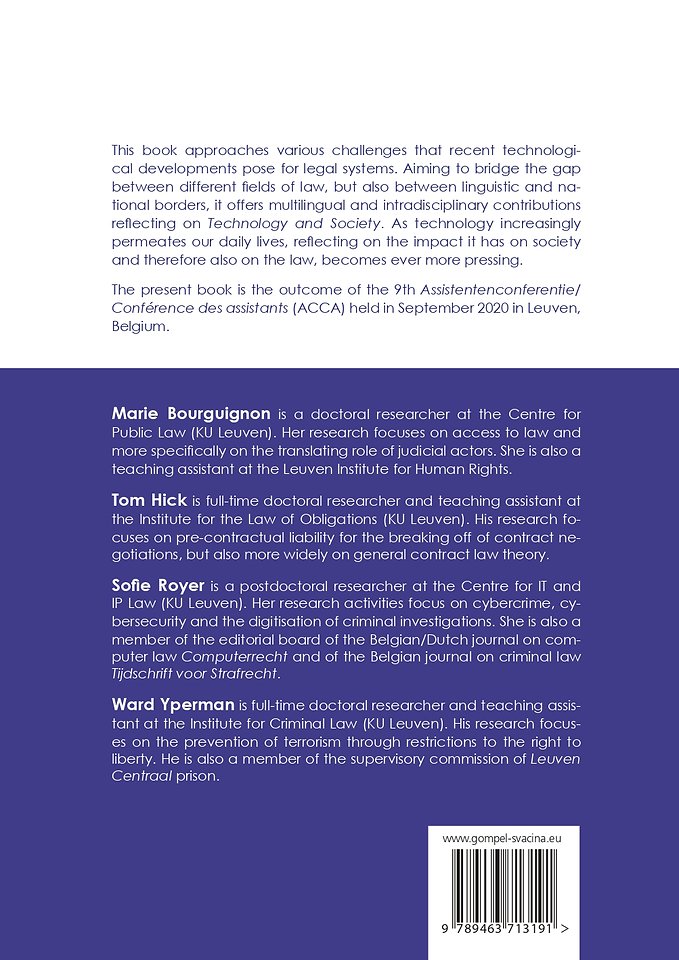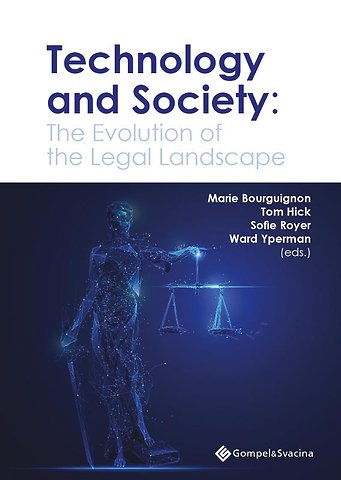


Marie Bourguignon is a doctoral researcher at the Centre for Public Law (KU Leuven). Her research focuses on access to law and more specifically on the translating role of judicial actors. She is also a teaching assistant at the Leuven Institute for Human Rights.
Meer over de auteursTechnology and Society:
The Evolution of the Legal Landscape (Belgisch recht)
Paperback Engels 2022 1e druk 9789463713191Samenvatting
This book approaches various challenges that recent technological developments pose for legal systems. Aiming to bridge the gap between different fields of law, but also between linguistic and national borders, it offers multilingual and intradisciplinary contributions reflecting on Technology and Society. As technology increasingly permeates our daily lives, reflecting on the impact it has on society and therefore also on the law, becomes ever more pressing.
The present book is the outcome of the 9th Assistentenconferentie/Conférence des assistants (ACCA) held in September 2020 in Leuven, Belgium.
Trefwoorden
Specificaties
Lezersrecensies
Over Tom Hick
Over Sofie Royer
Over Ward Yperman
Inhoudsopgave
U kunt van deze inhoudsopgave een PDF downloaden
Inleiding 19
Introduction 25
Marie Bourguignon, Tom Hick, dr. Sofie Royer & Ward Yperman
The Rise of Inter-Municipal Cooperation in the Technology Sector:
Easy Activity Update or Noiseless Nesting of a Virus? 31
Marie DeCock
1 Introduction 31
2 Inter-municipal cooperation in Belgium: basic principles 32
2.1 What? 32
2.2 Who? 33
2.3 Why? 34
3 The impact of technologisation and digitisation on the activities of local authorities 35
3.1 Case studies 35
3.1.1 Selected case studies 35
3.1.2 Fluvius 35
3.1.3 Cipal DV 37
3.2 The municipal interest at the core of local government: technological activities and their compatibility with the municipal interest 39
3.2.1 ‘The municipal interest’: undetermined but not unlimited 39
3.2.2 The changing economic role of the inter-municipal association 44
3.2.3 (Unwanted?) consequences of a functional approach 48
3.2.4 Compatibility with the municipal interest? 51
4 Conclusion 54
Bibliography 56
Algorithmic Accountability and the Right to Information: Towards Better Regulation of Algorithmic Social Media Platforms 59
Anne Oloo
1 Introduction 59
2 The problem with algorithms 60
2.1 Introduction 60
2.2 Loss of human control 62
2.3 Bias and discrimination 62
2.4 Opacity 63
2.5 Liability issues 64
2.6 Status of platforms 65
2.7 Filter bubbles, microtargeting, lack of diversity and pluralism 66
2.8 Spread of disinformation 68
2.9 Censorship 68
3 Algorithmic accountability 69
3.1 Definition and principles 69
3.2 Transparency 71
3.3 Loyalty of algorithmic systems 73
3.4 Due process and procedural regularity 74
3.5 Compliance with legal and ethical requirements 75
3.6 Responsibility and liability 75
3.7 Overview of principles 75
4 Algorithmic accountability: Methods to achieve algorithmic accountability 77
4.1 Fostering transparency 77
4.2 Auditing algorithms 78
4.3 Creating a new status for online platforms 80
4.4 Creating stronger legal accountability mechanisms 80
4.5 Introducing oversight mechanisms and overhauling the regulatory system 81
5 Regulation of Social media platforms – different approaches 82
6 Right to information and algorithmic accountability 83
6.1 Right to Information: Scope 83
6.2 RTI as a prohibition on (state) interference 85
6.3 RTI and positive obligations 86
6.4 RTI and pluralism 86
6.5 Grounding algorithmic accountability in human rights principles: application to RTI 87
7 Making platforms accountable 89
8 Conclusion 91
Bibliography 91
Legal and Ethical Challenges in Algorithmic Policing and Law Enforcement AI 97
Thomas Marquenie
1 Introduction 97
2 Artificial intelligence & algorithmic decision-making 98
3 Artificial intelligence & algorithmic decision-making in law enforcement 100
4 Obstacles to algorithmic fairness 103
4.1 Context 103
4.2 Discrimination and technical flaws 104
4.3 Opacity and unaccountability 107
5 Implications for human rights 110
5.1 Context 110
5.2 Fair trial 111
5.3 Privacy 113
5.4 Equal treatment 116
6 Conclusion 118
Bibliography 119
Op zoek naar de perfecte match: een juridisch-criminologische reflectie op de screening door de Belgische passagiersinformatie-eenheid 125
Jop Van der Auwera & Sven Bollens
1 Inleiding 125
2 De verzameling en doorgifte van passagiersgegevens 126
2.1 Toepassingsgebied 126
2.2 De Belgische passagiersinformatie-eenheid 128
2.3 De doorgifte van passagiersgegevens 129
3 De verwerking van passagiersgegevens in het kader van criminaliteitspreventie en
bestrijding 130
3.1 Ter ingeleide 130
3.2 De a priori analyse: de voorafgaande beoordeling van passagiers 131
3.2.1 Algemeen kader: een overzicht 131
3.2.2 De voorafgaandelijke controle 135
3.2.3 De post-validatiecontrole 153
3.3 De a posteriori analyse: de gerichte opzoekingen 154
4 Besluit 159
Bibliografie 160
Autonomie dans les systèmes d’armes : à la croisée des chemins entre
légalité et responsabilité pénale 165
Alyson Berrendorf
1 Introduction 165
1.1 L’autonomie dans les systèmes d’armes comme réalité 165
1.2 Autonomie croissante au sein des systèmes d’armes versus les
réactions politiques et juridiques 166
2 Essai de définition – intérêt d’une telle manœuvre 168
2.1 L’effet du langage et de la terminologie comme source de déterminisme 168
2.2 Pistes d’explications à l’absence de consensus terminologique 170
2.3 Tentative de définition 171
3 Aspects techniques et opérationnels 172
3.1 Introduction du concept unique d’autonomie, qui recouvre pourtant de multiples dimensions 172
3.2 L’autonomie comme spectre à trois vecteurs 174
3.3 Les conséquences et la nouveauté de ces armes par rapport à leurs prédécesseurs 176
4 Légalité 177
4.1 Questions choisies, aperçu 177
4.2 Questions choisies au regard du droit international humanitaire 178
4.2.1 Champ d’application 178
4.2.2 L’examen de licéité selon l’article 36 du PA I 179
4.2.3 Analyse au regard du weapons law et targeting law 182
4.2.4 Prévisibilité et fiabilité 185
4.3 Questions choisies au regard du droit international des droits humains 187
5 Responsabilité pénale 189
5.1 Introduction à la problématique 189
5.2 Sujet de la responsabilité, une responsabilité humaine versus robotique 189
5.3 Gap de responsabilité ? 191
6 Conclusion 193
Bibliographie 194
Wetenschap, technologie en de dual use-dilemma’s 197
Kwinten Dewaele
1 Inleiding 197
2 Exportcontrole in globaal perspectief 201
2.1 Raison d’être en ontwikkeling van het moderne exportcontrolebeleid 201
2.1.1 Historiek van het moderne exportcontrolesysteem 201
2.1.2 Nationale veiligheid als grondslag van het huidige exportcontrolebeleid 205
2.1.3 Individuele veiligheid als bijkomende doelstelling van het toekomstige exportcontrolebeleid? 209
2.2 Gelaagde rechtsorde en regelgevende dissonantie 212
3 Dual use: what’s in a name? 214
3.1 Definiëringsproblematiek 214
3.2 Materialistische opvatting: dichotomie civiel-militair en dual use sensu stricto 216
3.2.1 Materialistische benadering 216
3.2.2 Onderscheid civiel – militair 220
3.3 Intentionalistische opvatting: dichotomie positief – negatief gebruik en misuse 225
4 Een gemengd dual use-begrip en regelgevende dissonantie 230
Bibliografie 232
Fit for the Future: A Pragmatic Account of Human Autonomy to
Understand Emerging Issues in the Internet of Everything 239
Maximilian Gartner
1 Human autonomy as a catch-all concern for the Internet of Everything 239
2 Delimiting human autonomy 241
2.1 General theory, the duality of autonomy research and its relevance for legal studies 241
2.2 Historical context or why Immanuel Kant’s notion of autonomy is insufficient 243
2.3 Hierarchical autonomy theory 245
2.3.1 Foundations of hierarchical theory 245
2.3.2 Sneddon’s theory of autonomy 247
2.3.3 Hierarchical theory in the context of the IoE 249
2.4 Criticism and extensions of hierarchical autonomy theory 251
2.4.1 Procedure versus substance 252
2.4.2 Relevance of on agent’s relations and factual constraints 255
3 Proposal of a pragmatic account of autonomy 257
3.1 Objective and utility of the pragmatic account of autonomy 257
3.2 Methodical justification and objections to the pragmatic account of autonomy 258
3.3 Structure 263
3.4 Intrinsic dimension 265
3.4.1 Relational dimension 267
3.4.2 Transparency dimension 270
3.4.3 Moral dimension, historical dimension, dimension of scope 272
3.4.4 Dimension of utilisation 273
4 Conclusion 274
Bibliography 275
Het precontractueel gebruik van AI-systemen: het voordeel van de twijfel? 279
Maarten Herbosch
1 Inleiding 279
2 AI-systemen 279
2.1 Begrip 279
2.1.1 Algemeen 279
2.1.2 Machine learning 281
2.2 Eigenschappen 283
2.3 Precontractueel gebruik 288
3 Eerste hypothese: artificieel slecht advies 289
3.1 Algemeen 289
3.2 Impact op de totstandkoming 290
3.3 Impact op de geldigheid 290
3.4 Tussenbesluit 293
4 Contractsluiting via AI-systeem 293
4.1 Algemeen 293
4.2 Impact op de totstandkoming 295
4.3 Impact op de geldigheid 299
4.4 Tussenbesluit 300
5 Besluit 301
Bibliografie 302
Cryptovaluta en de blockchain: een ‘block’ aan het been van de wetgever? Bedenkingen over de verhouding tussen codes en recht 309
Niel Laenen
1 Inleiding 309
2 Technologie 311
2.1 Overzicht 311
2.2 Blockchain 311
2.3 Smart contracts 313
3 Conflicten tussen partijen: de blockchain en eigenrichting 314
3.1 Eigenrichting bij een onomkeerbare transactie 314
3.2 Naar een digitale rechtsstaat … 316
3.3 ... of naar een rechtsstatelijke digitale wereld? 317
4 Conflicten tussen de regels: “code = law”? 319
4.1 Conflicten tussen regulerende systemen 319
4.2 Fundamenteel verschillend karakter van de regulerende systemen 321
4.3 Theoretische perspectieven 321
4.3.1 Coherentism versus regulatory instrumentalism 321
4.3.2 Nationalisme versus ‘transnationalisme’ 323
4.4 Op zoek naar een constructieve samenwerking 323
4.5 Ultieme primauteit van het recht 325
5 Besluit 326
Bibliografie 328
Profiling in Private Health Insurance 331
Nele Stroobants
1 Introduction 331
2 Defining the relevant concepts of the GDPR 334
2.1 Personal data and health data 334
2.2 Solely automated individual decision-making and profiling 338
3 Relevance of profiling in private health insurance 344
4 Profiling in private health insurance 347
4.1 Legal basis 347
4.1.1 Explicit consent 348
4.1.2 Necessity for reasons of substantial public interest 351
4.2 Principles relating to processing of personal data, the data subject’s rights and suitable measures 355
4.2.1 Legal framework 355
4.2.2 Fairness 357
4.2.3 Purpose limitation and data minimisation 359
4.2.4 Accuracy and the right to rectification 360
4.2.5 Transparency and the right to be informed 364
4.2.6 Right to data portability 367
4.2.7 Suitable measures 368
5 Conclusion 371
Bibliography 373
Artificial Intelligence in Sports: Some Legal and Ethical Issues 377
Michiel Fierens
1 Introduction 377
2 The use of AI-systems in sports 378
2.1 Using AI-systems for athletes 378
2.2 AI-systems for scouting, coaching and tactical decision-making 379
2.3 AI-systems to assist/replace humans in refereeing sports 381
3 Processing of data and data protection 381
3.1 Introduction 381
3.2 The application of fundamental GDPR-principles and AI-systems
in sports 383
3.3 An athlete’s consent for the processing of data 385
3.4 Requirement of a data protection impact assessment and AI-systems 387
3.5 Profiling and automatic decision-making towards youth talent 388
3.5.1 Profiling and automatic decision-making 388
3.5.2 Profiling and automatic decision-making towards youth talent 390
3.6 Data-ownership 393
4 Cybersecurity 395
4.1 Examples of cyber-attacks 395
4.2 Possible solutions 397
5 Some other legal and ethical challenges 400
6 Conclusion 403
Bibliography 403
Anderen die dit boek kochten, kochten ook
Rubrieken
- advisering
- algemeen management
- coaching en trainen
- communicatie en media
- economie
- financieel management
- inkoop en logistiek
- internet en social media
- it-management / ict
- juridisch
- leiderschap
- marketing
- mens en maatschappij
- non-profit
- ondernemen
- organisatiekunde
- personal finance
- personeelsmanagement
- persoonlijke effectiviteit
- projectmanagement
- psychologie
- reclame en verkoop
- strategisch management
- verandermanagement
- werk en loopbaan





